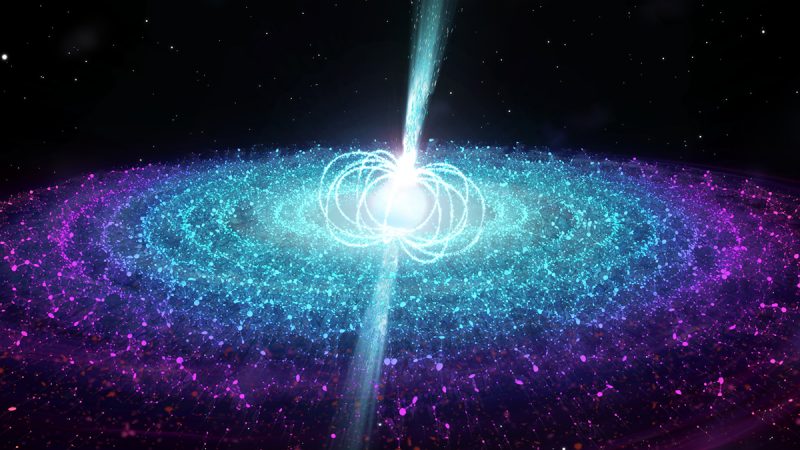In recent decades, jets have been a key part of the cosmic landscape. Astronomers see jets emanating from various kinds of star systems, and from the area of both massive and supermassive black holes, but they are far from understanding them completely. On September 26, 2018, astronomers announced they used the Very Large Array (VLA) west of Socorro, New Mexico, to discover a fast-moving jet of material propelled outward from a type of neutron star previously thought incapable of launching such a jet. The discovery, the scientists said, requires a fundamental revision in their ideas about how such jets originate.
Neutron stars are evolved stars – now superdense – that remain when a massive star explodes as a supernova. Jets from such stars occur in a commonly seen configuration of objects, where the very dense neutron star is paired with another star and pulls gravitationally on the other star. The material flowing from the other star forms a disk around the neutron star. Jets are seen perpendicular to the disk, propelled outward by some as yet not-understood mechanism at nearly the speed of light.
Jakob van den Eijnden of the University of Amsterdam is first author of the new study, which is published in the peer-reviewed journal Nature. He said:
We’ve seen jets coming from all types of neutron stars that are pulling material from their companions, with a single exception. Never before have we seen a jet coming from a neutron star with a very strong magnetic field.
That led to a theory that strong magnetic fields prevent jets from forming.
Now that theory may have to be revised.

These scientists’ statement said they:
… studied an object called Swift J0243.6+6124 (Sw J0243), discovered on October 3, 2017, by NASA’s orbiting Neil Gehrels Swift Observatory, when the object emitted a burst of X-rays. The object is a slowly-spinning neutron star pulling material from a companion star that is likely significantly more massive than the sun.
The VLA observations began a week after the Swift discovery and continued until January 2018.
Both the fact that the object’s emission at X-ray and radio wavelengths weakened together over time and the characteristics of the radio emission itself convinced the astronomers that they were seeing radio waves produced by a jet.
Van den Eijnden said:
This combination is what we see in other jet-producing systems. Alternative mechanisms just don’t explain it.
Common theories for jet formation in systems like Sw J0243 say the jets are launched by magnetic field lines anchored in the inner parts of the accretion disks. In this scenario, if the neutron star has a very strong magnetic field, that field is overpowering and prevents the jet from forming. Van den Eijnden said:
Our clear discovery of a jet in Sw J0243 disproves that longstanding idea.
Or, there’s another possibility:
… the scientists suggest that Sw J0243’s jet-launching region of the accretion disk could be much farther out than in other types of systems, where the star’s magnetic field is weaker.
Another idea, they said, is that the jets may be powered by the neutron star’s rotation, instead of being launched by magnetic field lines in the inner accretion disk.
Nathalie Degenaar, also of the University of Amsterdam, said:
Interestingly, the rotation-powered idea predicts that the jet will be significantly weaker from more slowly rotating neutron stars, which is exactly what we see in Sw J0243.
The new discovery also implies that Sw J0243 may represent a large group of objects whose radio emission has been too weak to detect until new capabilities provided by the VLA’s major upgrade, completed in 2012, were available. If more such objects are found, the scientists said, they could test the idea that jets are produced by the neutron star’s spin.
The astronomers added that a jet from Sw J0243 may mean that another category of objects, called ultra-luminous X-ray pulsars, also highly magnetized, might produce jets. Degenaar said:
This discovery not only means we have to revise our ideas about jets from such systems, but also opens up exciting new areas of research.

Bottom line: Astronomers had theorized that strong magnetic fields prevent neutron star jets from forming. Then they studied an object called Swift J0243.6+6124 (Sw J0243) – a strongly magnetized neutron star – with a jet.
Source: An evolving jet from a strongly magnetized accreting X-ray pulsar











